Collibra AI Governance offers a holistic end-to-end view of all your organization's AI projects. It is designed to help you:
- Improve your organizational access to, and adoption of, AI systems.
- Promote visibility, productivity, compliance and accountability around AI use cases, AI models, and AI agents.
- Mitigate risks associated with AI, such as data privacy, intellectual property, and ethical risks.
- Prevent the duplication of efforts in the development and adoption of AI systems.
- Drive meaningful business evaluations of AI use cases prior to investing in them.
- Enable cross-functional collaboration, to address the internal use of AI systems for common business functions.
Let's walk through the process flow
This topic describes the Collibra AI Governance process flow, from registering an AI model or AI use case, to collaborating to assess the AI model or AI use case, and finally approving the Assessment Review asset.
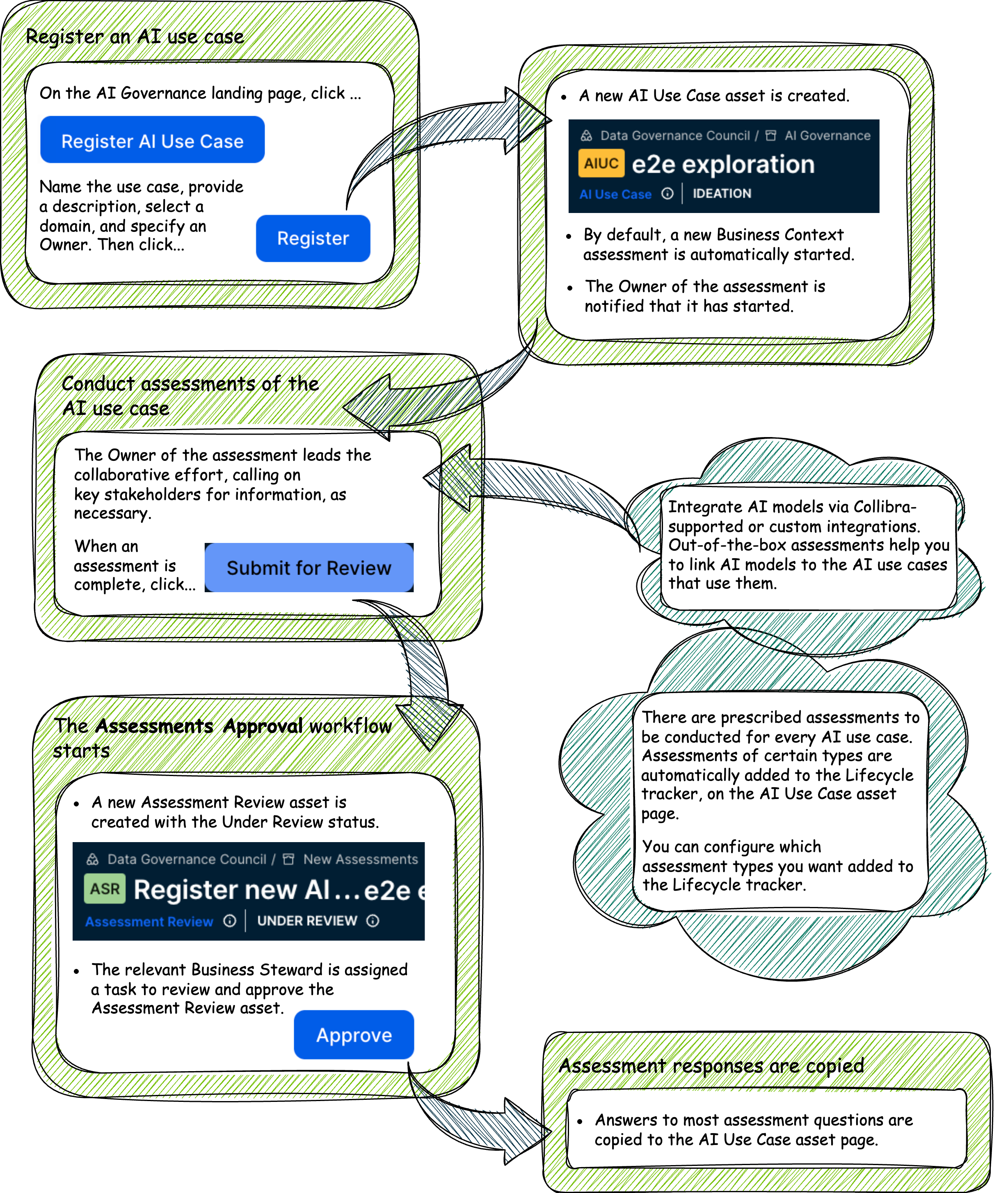
The process starts with an AI use case
A Business Steward kicks off the process by registering the use case. AI Governance aims to remove the burden and the intimidation for Business Stewards who want to register AI use cases. This first step is often the biggest hurdle. The objective at this point is simply to register the use case. Don't worry if you don't know all of the details relative to the use case. Once the use case is registered, providing the details of the business value and associated risks is a collaborative effort.
On the AI Governance Overview page, click Register AI Use Case. In the Register AI Use Case dialog box, you only need to provide a name and a description, and specify a domain and an owner. That's it.
You can also register a use case from the AI Legal Reviews page.
When you click Register, a few things happen:
- An AI Use Case asset is created in the specified domain. You can view the Owner and all other assigned responsibilities in the Responsibilities tab on the AI Use Case asset page.
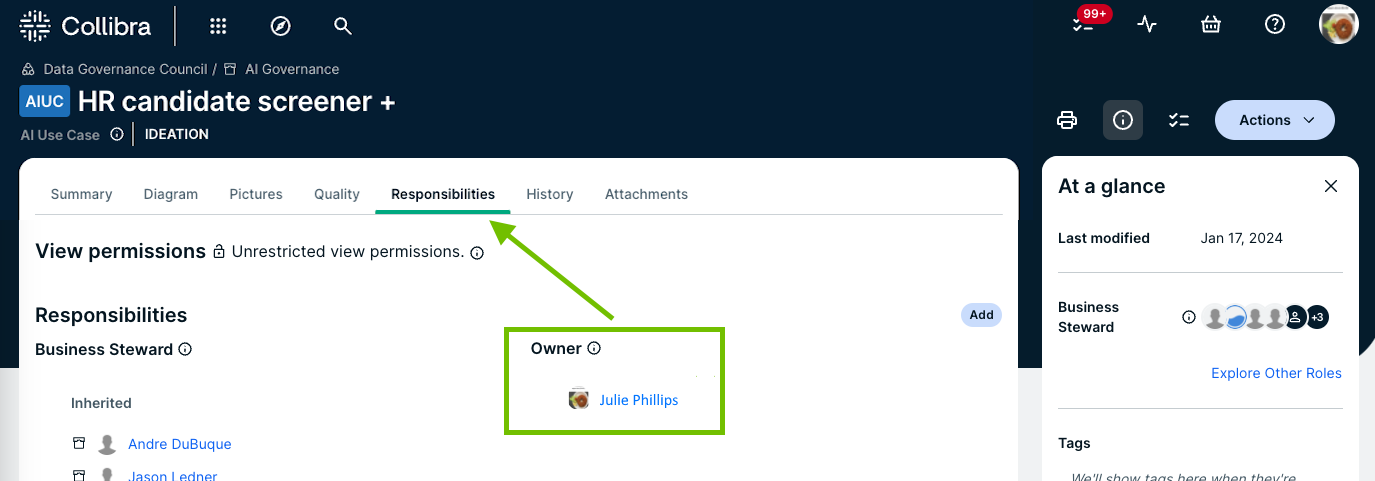
- A new assessment is started. The Owner of the AI use case is automatically assigned the Owner of this assessment. For all other assessments, the user who starts the assessment is automatically assigned the Owner of the assessment.Tip You can configure which assessment types and sign-off activities are automatically added to the Lifecycle tracker, and which assessment type starts automatically when a new AI model or AI use case is registered. For complete information, go to Configuring AI Governance asset types.
- On the asset page, the following out-of-the-box assessment types are, by default, automatically added to the Lifecycle tracker:
- Business Context
- Data and AI Models
- Legal and Ethics
- Risks and Safeguards
As shown in the following example image, the Draft status of the Business Context assessment identifies that it is started.
AI Governance asset pages: your single source of truth
The AI Governance asset pages are working records where stakeholders can collaborate as an AI agent, AI model, or AI use case evolves, to capture critical details as they become known. The asset pages are intended to be a single source of truth, where all stakeholders can quickly identify the business value and all associated risks.
When it's time to review and approve the use case, every stakeholder involved in the project has easy access to all of the business and technical information needed to complete the evaluation, including:
- The business case.
- The business value description.
- Information about the training and inference datasets, their categories, sources, quality and lineage.
- The AI agents and AI models at the center of the use case.
- Legal and Privacy teams' insights on associated risks.
- Links to the assessments conducted with respect to the use case.
- The stakeholder roles and responsibilities associated with the use case, for example Legal Steward, Privacy Steward and Data Protection Officers.
The out-of-the-box AI Governance domain: your AI use case register
AI Governance comes with the out-of-the-box AI Governance domain, which you can use as your AI use case register. You're free, however, to create a new domain or use another existing domain to store your AI use case assets.
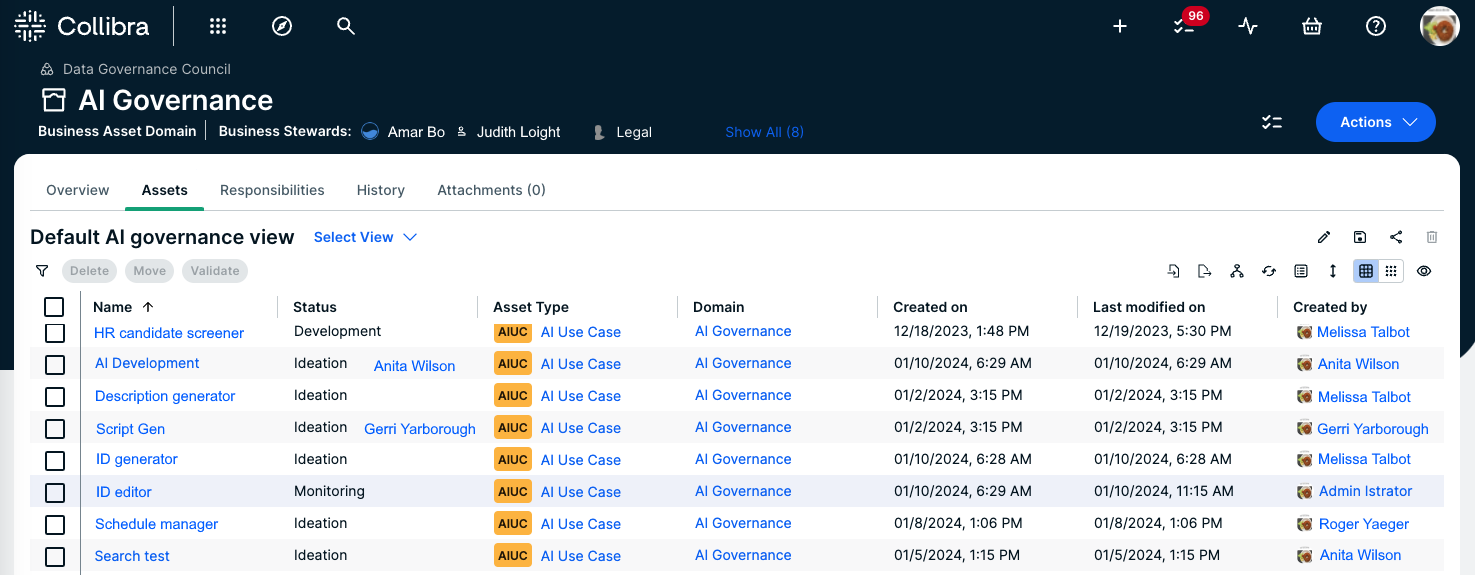
Integrate and manage your AI models
We offer the following Collibra-supported AI integrations:
- AWS Bedrock AI
- AWS SageMaker AI
- Azure AI Foundry
- Azure ML
- Databricks Unity Catalog
- Google Vertex AI
- MLflow AI
- SAP AI Core
Important These integrations are only available via Edge, not via Jobserver.
If our Collibra-supported integrations don't suit your needs, you can perform a custom integration. On the Collibra Developer Portal, you can find a tutorial explaining how to use Python to create and synchronize AI Models in Collibra.
AI model lifecycle management
AI model lifecycle management is essential for organizations dealing with numerous AI models running simultaneously across different departments. The Model Registry (in preview), helps Data Scientists and other stakeholders:
- Manage AI models through defined lifecycle stages.
- Maintain control over AI model development.
- Ensure compliance with organizational policies, ethical principles, and AI regulations.
By addressing the challenges faced by data scientists and AI leaders in managing AI model lifecycles, AI Governance enables them to effectively execute AI initiatives and deliver business value through collaboration between all stakeholders.
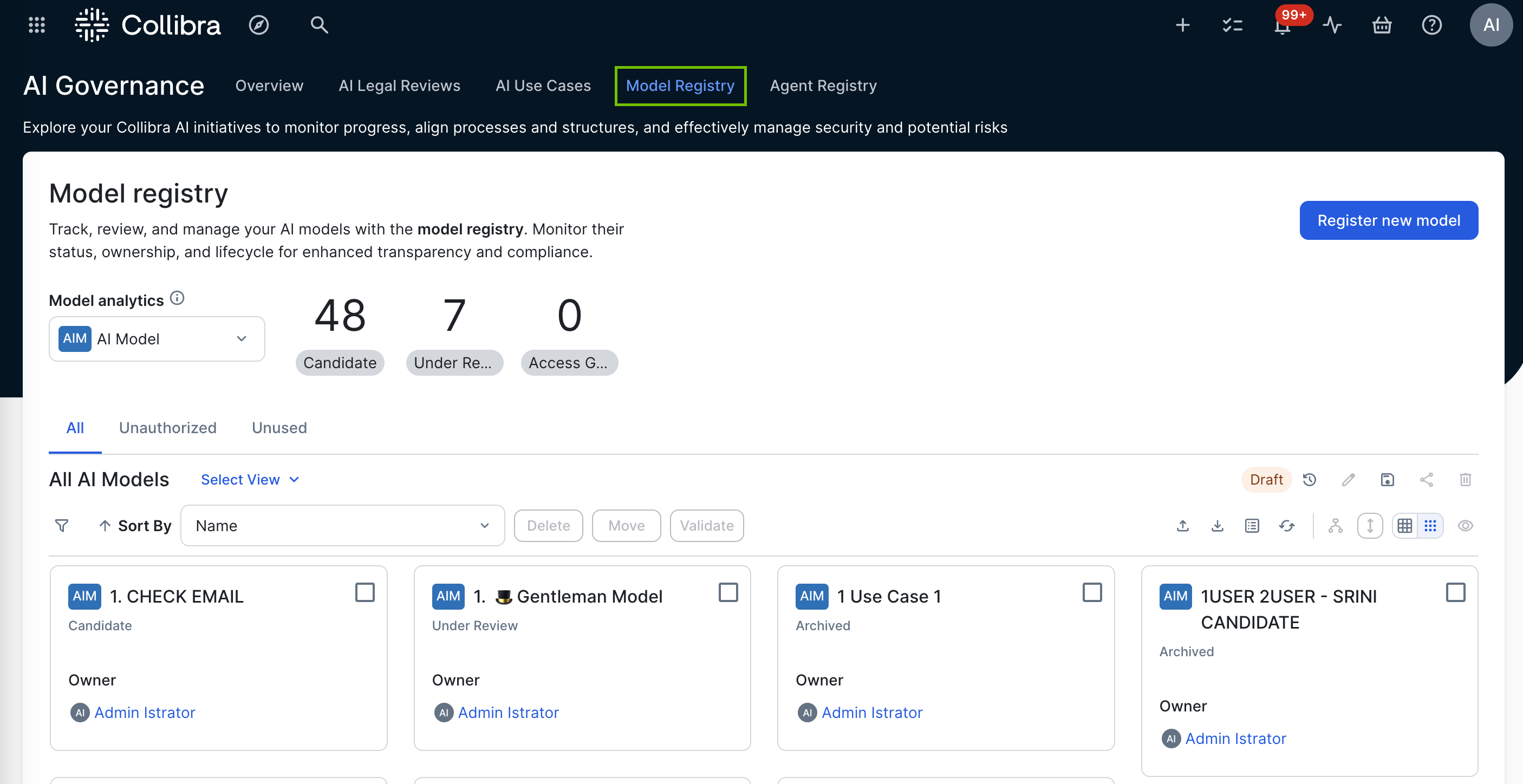
Link your AI use cases to the AI agents and AI models they use
Linking your AI use cases to the AI agents and AI models they use is critical for optimizing the effectiveness and efficiency of your AI project.
The AI Governance assessments are designed, in part, to automatically link your AI agents and AI models to the AI use cases that use them. For example, when you conduct a Data and AI Modelsassessment of an AI use case, you are prompted to specify any AI models used by the use case. Likewise, the Model Business Context assessment prompts you to specify which AI use cases use the AI model that you are assessing. Collibra then adds the relevant relations, effectively linking the assets.
However, you don't have to conduct an assessment in order to link AI Governance assets. You can manually add the relations via asset pages.
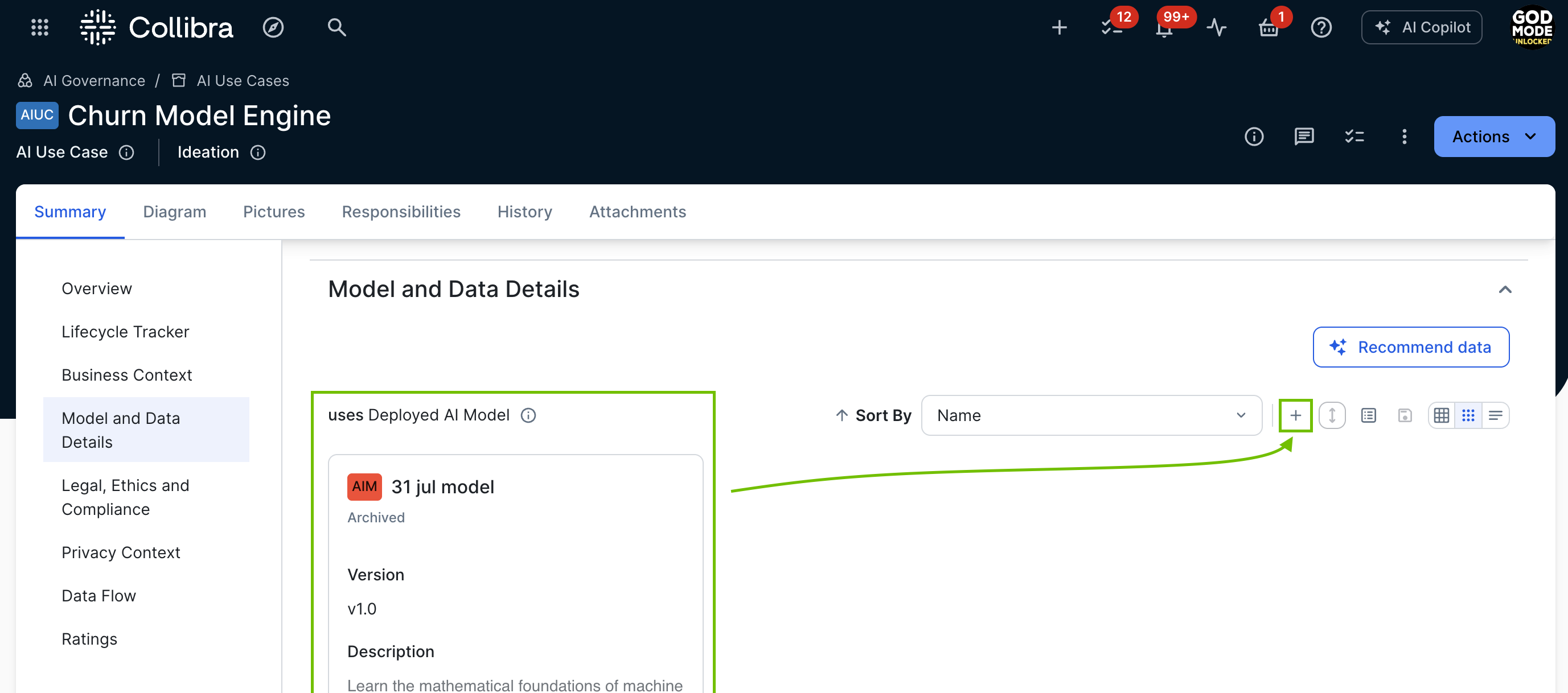
The benefits of linking your AI use cases to the AI agents and AI models they use include the following:
- Provide a clear understanding of which AI agents and AI models are responsible for specific tasks, to facilitate project management and resource allocation.
- Allow for precise tracking and evaluation of AI performance within specific use cases, making it easier to identify areas for improvement.
- Simplify the process of identifying and addressing issues by pinpointing the exact AI components involved in a use case.
- Enable more informed decision-making by providing detailed insights into the effectiveness of different AI agents and AI models in various contexts.
- Help scale AI applications by understanding which AI agents and AI models are most effective, and adapting them to new or expanding use cases.
- Foster a culture of ongoing refinement and optimization by regularly assessing the performance and relevance of AI agents and AI models in relation to their use cases.
Assessments: a tool for driving collaboration
The Owner is responsible for driving the assessment, but collaboration from Analytics, Data Offices, Legal, Privacy teams, and so forth, is essential to ensuring that all critical details and associated risks are identified and recorded in the assessments.
AI Governance uses the Collibra Assessments app and features to enable stakeholders to add essential details to your AI use cases and document associated risks.
Collibra comes with the following out-of-the-box assessment templates:
| Type | Template | Associated asset type* | Description |
|---|---|---|---|
| AI Governance | Business Context | AI Use Case | Allows you to provide details about how your AI use case will impact the business. Your organization will use this information to understand the business needs and requirements associated with implementing your AI use case. |
| AI Governance | Data and AI Models | AI Use Case | Allows you to provide details about the AI models and data that will be used for the AI use case. Your organization will use this information to understand the potential workload and risks associated with implementing your AI use case. |
| AI Governance | Legal and Ethics | AI Use Case | Helps you to identify potential legal and ethical risks associated with the AI use case. Answers will become a part of the AI use case definition. |
| AI Governance | Risks and Safeguards | AI Use Case | Helps you to identify and document potential business-related risks associated with the AI use case, as well as available safeguards. This will help your organization determine the overall risk of this Use Case. |
| AI Governance | EU AI Act Assessment | AI Use Case | Helps you to determine the applicability of the European Union's Artificial Intelligence Act to a proposed AI use case. |
| AI Governance | NIST AI Risk Management Framework (in preview) | AI Use Case | Helps you align with the NIST AI Risk Management Framework by evaluating AI systems across its core functions — Govern, Map, Measure, and Manage — to support responsible and trustworthy AI use. |
| AI Governance |
Model Business Context |
AI Model | Helps you to define business context, estimate resources, identify stakeholders, and ensure alignment with goals and organizational constraints. |
| AI Governance |
Model Information Collection |
AI Model | Allows you to provide details about the AI model you'll be training and using. |
| AI Governance |
Model Data Collection |
AI Model | Allows you to provide details on the data you will use and collect with the AI model that is being assessed. |
* For information on associated asset types, go to Asset type in a template.
These templates were designed with insights obtained from extensive research and interviews with Collibra users and data professionals, to elicit critical input and considerations from the key stakeholders in your organization.

Notify assessment Owners and Assignees
You can use the notifications feature in your assessment templates to ensure that:
- Assessment Owners are notified when a new assessment is started.
- Assignees are notified when they are assigned to an assessment.
In the Properties sidebar of any assessment, you can identify the two resource role assignments: Owner and Assignees.
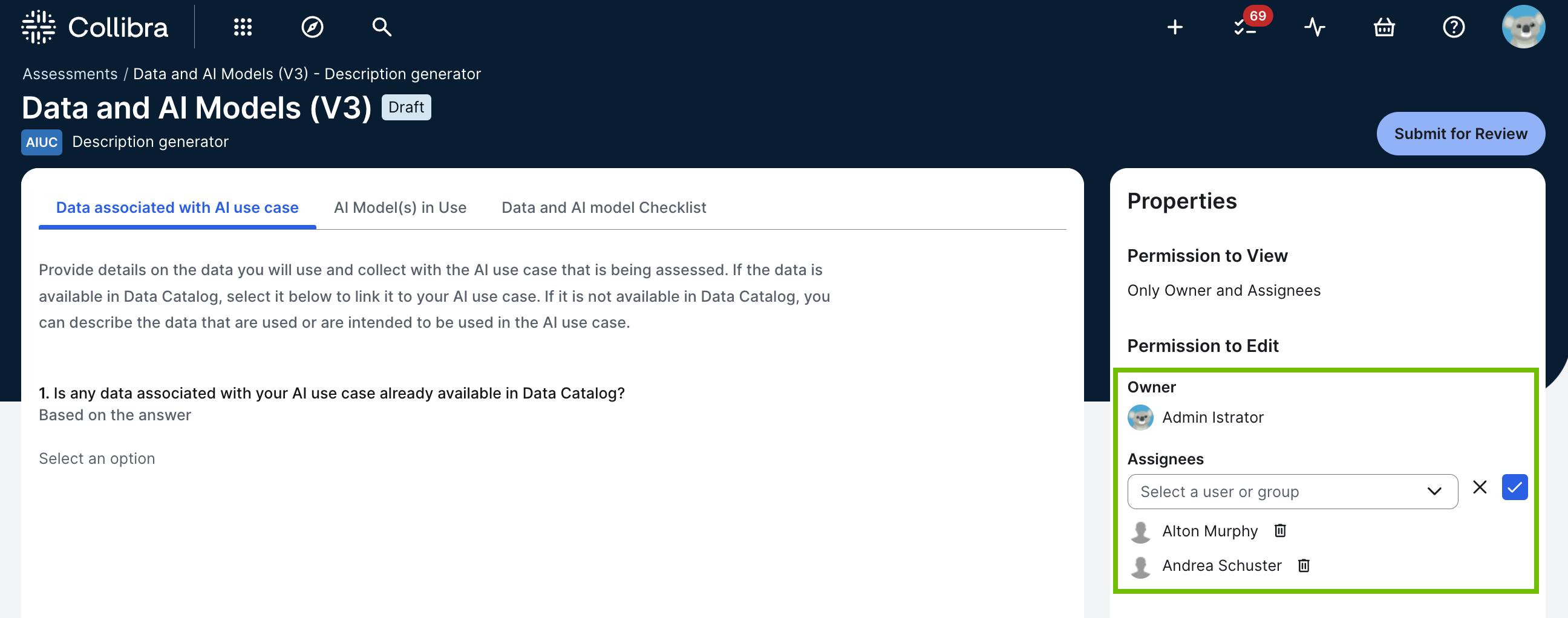
By default, notifications are switched on for the out-of-the-box AI Governance assessments and any custom assessments that were created as of the release of Collibra version 2024.10.
For more information on notifications, go to Assessment notifications.
Completing the process: Approving the assessments
When an assessment is complete and the Owner clicks Submit for Review:
-
An Assessment Review asset with the status Under Review is created in your Collibra environment (if the Require a review option was selected in the template that was used to conduct the assessment), in the domain of their choice.

- The Assessments Approval workflow is triggered and the Business Steward for the domain receives a task to approve or reject the Assessment Review asset.
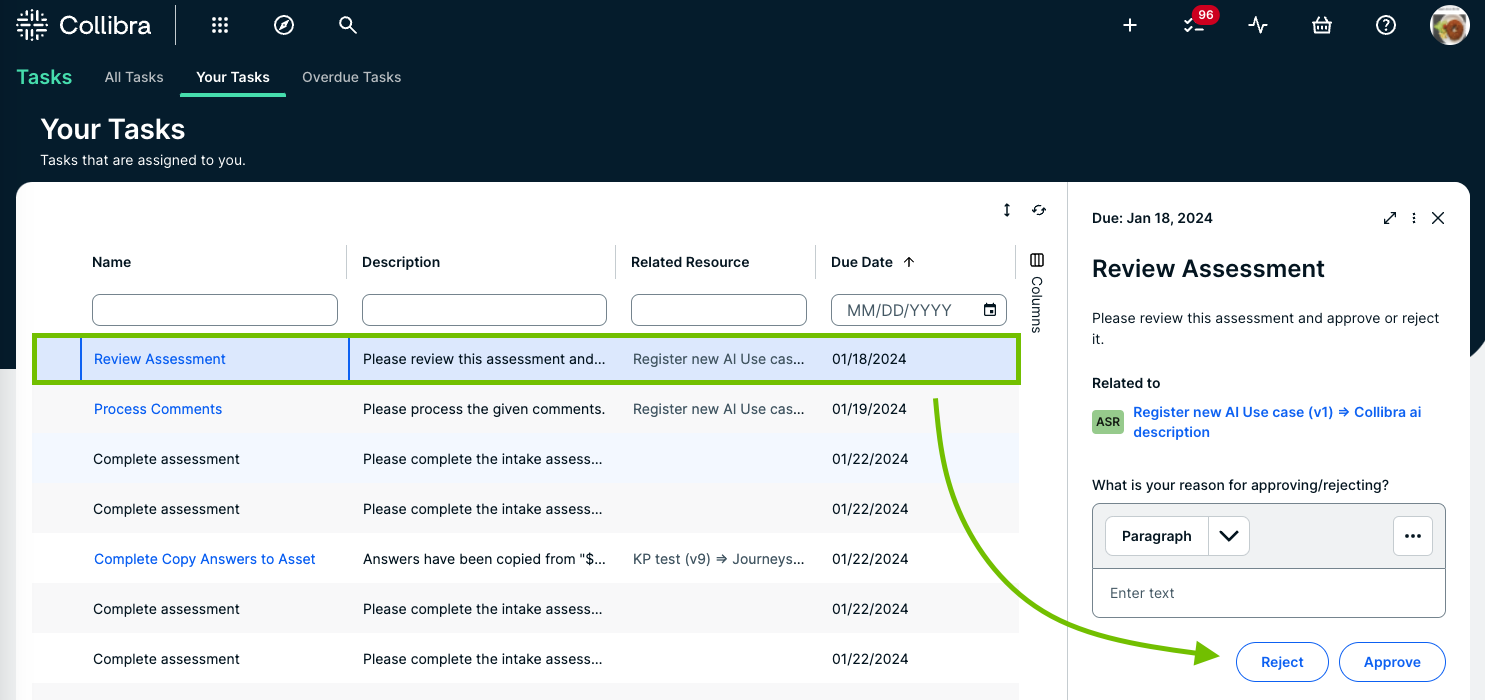
When the assessment is approved, depending on the assessment type, certain assessment responses are copied to the AI Model or AI Use Case asset page. The following table shows the conditions under which responses are copied to the asset page.
| If the assessment type is... | Then... |
|---|---|
| One of the out-of-the-box AI Governance assessment types |
Certain assessment responses are automatically copied over to the asset page. For a complete list of questions for which responses are copied to the asset page, and how they map to the characteristics on the asset page, go to Mapping of copied assessment responses and asset characteristics. |
| Any custom assessment type |
The response to every question for which the "Copy Response to Assessed Asset" option is selected in the assessment template, are copied to the asset page. For complete information, go to Copy response to asset. |